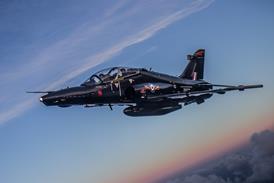With air freight in Europe – particularly feeder services – on the verge of strong growth, a Swedish-British partnership believes it has found an innovative way of capitalising on market conditions while helping to build momentum.


Sweden's West Air is investing €45 million ($45 million) on converting smaller airframes in the belief that 30-40 freight aircraft of 6–9t capacity will soon be needed in Europe. It has backed these beliefs with a new freight solution provided through a partnership with BAE Systems.
The partners are converting Advanced TurboProp (ATP) and BAe 748 aircraft to all-freight configuration, featuring a large freight door developed jointly by BAE Systems in Prestwick, Scotland and West Air. An example of the new large-door ATP conversion is on display this week at Farnborough.
The design uses a mechanism allowing the door to slide alongside the fuselage, leaving an aperture 2.64m wide by 1.73m high aft of the port wing, a position which permits ease of use and maximum container capacity.
Efficient
With its E-class configuration, the ATP freighter has no compartments, making loading and off-loading easier and the use of space more efficient.
Explains Gustav Thureborn, West Air's managing director: "When fully stripped, the E-class cabin used on the large door freighter has a volume of 74m3 (2,095ft3), with a gross payload of 7,880kg (17,350lb). Also, each is available with strengthened flooring, apron lighting, tail steady and 9g restraint netting."
West Air owns 17 aircraft, many of which are converted or are in the early stages of conversion to all-freight use. Nine of its aircraft are 748s and eight ATPs. One ATP has so far been converted to the new large door format. BAE pegs at 70 the total number of aircraft that could potentially be converted.
Payload
The company, whose current revenues are around €30 million, launched its freight operation in 1995. For two years, Swedish Mail was West Air's only customer, before new markets opened up when Sweden joined the European Community.
"Many national carriers such as KLM and Lufthansa may well ask for an efficient feeder service in the future and we will be there to provide that," says Thureborn.
"An increasing number of companies are demanding more effective freight solutions. We will be able to provide them with the use of the large-door freighter. Many of the logistics decisions within these companies are now being taken, so at West Air we believe we have come into the market with the new ATP at just the right time."
Says Thureborn: "Mail containers utilise almost all the cabin volume of the ATP. The whole aircraft can be loaded within 10 minutes. It's an important benefit to the ATP as time can be critical, especially when feeding into a hub system and for short-haul journeys."
The capacity of the ATP large door freighter is 8-8.5t, comprising five full LD4 containers and two half LD4s, or eight LD3s. The ATP offers 36% more volume and 33% more payload than the 748.
The large-door ATP has a range of nearly 2,300nm (4,300km) with a full payload. Maximum cruise speed is 260kt.
Phil Rogers, director, business support for BAE Systems, says the ATP offers a 50% increase in range over the 748. "With airframes using the large freight door, the benefits increase even further as the time taken to load the aircraft is reduced, permitting a much quicker turnaround and the option of more flights in a given time period."
Source: Flight Daily News























